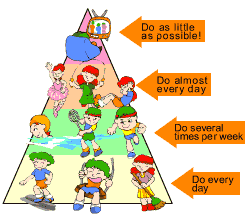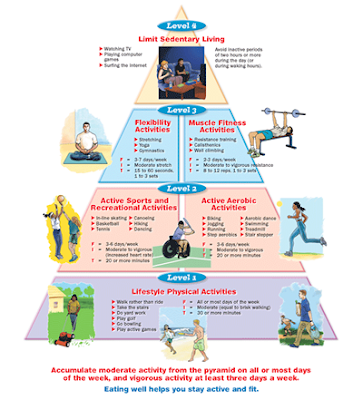Katie Meyers
Ethical Essay Three: Exercise – Is The Concept Working?
Whenever a person browses the Internet, he or she will be barraged by a tidal wave of advertisements. Many of these advertisements offer tantalizing claims – “Lose Weight Fast (so you can fit into that swimsuit next weekend)!” “Lose 10 pounds in only 3 days!” “Effortlessly Lose Weight And Eat Whatever You Want!” This is just a very small sample of what awaits the unsuspecting web surfer. However, these sayings bring about a large personal and social problem: obesity and exercise. Most of us would heartily agree that exercise has always been seen as a positive addition to one’s everyday life. Very few in the world see exercise as a negative activity, even unhealthy for oneself! If this is such a well-established way of thinking, why is obesity on the rise? Also, what are we to do to correct this societal mistake?
Let us first address why obesity levels are increasing throughout the world. According to Environmental Health Perspectives (http://www.ehponline.org/docs/2005/7812/7812.html), the problem can be found in our environment. The environmental changes made by humans, like a constant supply of inexpensive (and unhealthy) food and technology that saves us physical labor, have facilitated weight gain. There are four environmental “genres” to look at that show, more specifically, what is wrong with the contemporary human environment. In the built environment, we see that what we have built into our environment has helped promote obesity. For example, we have built up our society and environment to a point where our energy intake exceeds our energy output and eliminated the need for physical activity with technology. Then, in our commercial environment, food and exercise marketing has affected and continues to affect obesity levels. When it comes to food marketing, we all know how we are deluged by food advertisements wherever we are: airports, billboards, TV. Also, foods most marketed are foods full of fat and sugar, which should be eaten sparingly. It is even thought that food advertising of unhealthy foods to children is a significant factor in current obesity levels. When it comes to exercise, lack of exercise is essentially advertised with gadgets like DVDs, video games, computers, and the Internet that encourage sedentary entertainment. Next, there is policy environment. Today’s policies have encouraged things like super-sized value meals (with the “cheap/get more food” policy) and human reliance on automobiles (however, current gas prices might aid society in eliminating some of that dependency). Lastly, there is our social and cultural environment, which just might be at the heart of this obesity issue. What society values today is easily represented by Wal-Mart’s slogan: “We sell for less.” Also, society has the “get it now” mindset. Because of this, it will be very difficult to convince society to make dietary and activity changes that will pay off anywhere from a year to several decades from now. That is also why the advertisements mentioned in the first paragraph are so popular today – they offer a quick, easy fix that does not require lifestyle changes. Today, we have a desire for great deals (remember that super-sized value meal?) rather than moderation. Together, this has greatly affected and helped cause our current state of obesity.
Now that we know why we are an obese society (largely because of lack of exercise), how might we fix this problem and reverse the epidemic? Unfortunately, this is an even harder question to answer than the last one. The options and tactics seem to be endless at times. However, I will give you examples of what some countries, committees, communities, and groups are doing to answer this question. In

Lastly, there is a group called “Fitness for Life” (http://www.fitnessforlife.org/HighSchool/student/4/4/), which targets junior high and high school children. Their goal is to make these children aware of what a healthy lifestyle is, and what its benefits are. Here is their physical activity pyramid.

I have shown you examples of what other people have thought to do to fix our exercise/obesity problem. However, after I have researched this subject, and from what I have gleaned from this research, these are some tactics I think have merit. First of all, society should be made aware that, to reap benefits, we must make a long-term commitment to the healthier lifestyle. The “lose lots quick” mindset is not beneficial in the long run, and can even be harmful. Also, society’s individuals should increase their daily activity in fundamental ways and with simple choices (as shown by the bottom level of the “Fun-In-Seven” physical activity period): choose stairs over the elevator; park at the first parking spot you find, no matter how far away it is; and, walk to your destination if it is in walking distance, whether it is to/from home, work, or shopping. Moreover, society should be notified that exercising does not have to be a miserable experience. For example, if you are a female who would like to exercise (for free) on a hot day, walk the mall interior and window shop. You can stroll, walk briskly, or alternate between the two. Also, people (from children to seniors) should be made aware of the benefits of exercise. First of all, it improves: muscular strength and endurance, flexibility, and cardiorespiratory endurance. It also prevents certain cancers, relieves depression/enhances mood, and, with the use of weights during exercise, improves bone density and strength as well as muscle strength and endurance. Above all, we should remember that this crisis came about gradually by many small changes over a long period of time. As a result, permanently fixing this problem will also take many small changes over a long period of time. Here are some changes recommended by Environmental Health Perspectives (http://www.ehponline.org/docs/2005/7812/7812.html): organize safer sidewalks, modify food supply and availability, make healthier vending machine options available, give technology a physical activity side, educate children on the positive side and importance of exercise and a healthy lifestyle, give employees incentives to achieve healthier lifestyles, and find the desire for long-term lifestyle change.
I think many of the examples concerning organizations for the improvement of lifestyle are on the right track. I also think that the article I read from the Environmental Health Perspectives website (http://www.ehponline.org/docs/2005/7812/7812.html) was sound-minded and full of good advice. The problem with the mindset of exercise is this: exercise should be part of each person’s life, not a punishment for how they look. Physical activity is fundamental to everybody’s health. As a society, and as individuals, we have wandered away from this truth. In the end, we need to come together, as a society of individuals, and gradually but permanently tackle the twisted view of physical activity surrounding us today.

1 comment:
Katie,
I like how you mentioned other countries than our own such as China, in order to incorporate America’s obesity problem. I also liked that you started this essay by relating to people, by showing how there are a numerous amount of articles on how to lose weight. I didn’t think that there was much to be improved on your essay, because it covered so many points of obesity and exercise in our country, and others as well. Something that I hadn’t thought about is the many exercise programs that other countries have, and maybe if we incorporated more exercise programs, rather than crash diets and pill forcing, then we may not be the country with the highest obesity rates. Something that surprised me was the fact that Hong Kong has a program that combats childhood obesity, and it seems that in our country people don’t worry about obesity in children as much as adults, when it is too late to correct.
Tamara
Post a Comment